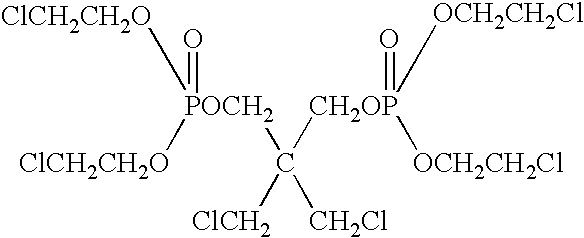Dye diffusion promoting agents for aramids
a technology of diffusion promotion and aramids, which is applied in the direction of dyeing process, textiles and papermaking, fibre treatment, etc., can solve the problems of difficult dyeing of aramids, product unpleasant odor, and difficult fiber processing of aramids, and achieve the effect of increasing the loi valu
- Summary
- Abstract
- Description
- Claims
- Application Information
AI Technical Summary
Benefits of technology
Problems solved by technology
Method used
Image
Examples
Embodiment Construction
The following examples offered are by illustration and not by way of limitation. All parts and percentages herein are given by weight unless otherwise specified.
Additional assessments, comparisons and other useful information suggest themselves from the examples that follow.
1. Dyeing—A bath weighing 200 g was prepared containing 0.2 g of Acid Blue 62 and 6 g of the candidate dye diffusion promoting agent. In this aqueous bath, 10 g of weighed Nomex fabric, conditioned at 70° F. and 65% RH, was dyed at 130° C. for 1.5 hours.
After dyeing, the fabric was rinsed in warm tap water, and then scoured in fresh tap water at 100° C. in the Ahiba Vistamatic apparatus for 15 minutes. The bath was cooled and discarded, and the fabric was rinsed in fresh tap water, squeezed to remove excess liquid and allowed to air dry overnight. The fabric was then rinsed twice in cold, fresh acetone, air dried, and conditioned prior to weighing. The change in weight compared with the initial conditioned weight...
PUM
| Property | Measurement | Unit |
|---|---|---|
| temperature | aaaaa | aaaaa |
| temperature | aaaaa | aaaaa |
| LOI | aaaaa | aaaaa |
Abstract
Description
Claims
Application Information
 Login to View More
Login to View More - R&D
- Intellectual Property
- Life Sciences
- Materials
- Tech Scout
- Unparalleled Data Quality
- Higher Quality Content
- 60% Fewer Hallucinations
Browse by: Latest US Patents, China's latest patents, Technical Efficacy Thesaurus, Application Domain, Technology Topic, Popular Technical Reports.
© 2025 PatSnap. All rights reserved.Legal|Privacy policy|Modern Slavery Act Transparency Statement|Sitemap|About US| Contact US: help@patsnap.com

